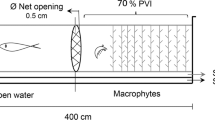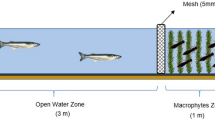Abstract
Eight cylindrical enclosures (3 m diameter, 2.7 m long, V = 20m3) were installed in eutrophic Rice Lake (Ontario, Canada) in late spring of 1987. Fish (yearling yellow perch (Perca flavescens) and macrophytes (Potamogeton crispus) presence and absence were set at the beginning of the experiment to yield four combinations of duplicate treatments. The purpose of the experiment was to determine if the phytoplankton, zooplankton, macrophytes and fish species resident in the lake interact to influence water quality (major ions, phosphorus, algal densities and water clarity).
The presence of fish was associated with: (1) decreased biomass of total zooplankton, (2) decreased number of species in the zooplankton, (3) decreased average size of several zooplankton taxa, (4) higher total phosphorus concentrations, (5) higher phytoplankton and chlorophyll a concentrations, (6) lower water clarity, (7) lower potassium levels during macrophyte die-back, (8) lower pH and higher conductivity in the presence of macrophytes. Biomass of large Daphnia species (but not total zooplankton) was highly correlated with the algal response (r 2 = 0.995) and was associated with reduced biomass of several algal taxa including some large forms (Mougeotia, Oedogonium) and several colonial blue-green algae. However, no significant control of late summer growth of the bloom-forming blue-green alga Anabaena planctonica Brun. was achieved by the Daphnia presence-fish absence treatment. Release of phosphorus to the water column during the die-back of P. crispus was not an important phenomenon.
Similar content being viewed by others
References
Andersson, G., W. Granéli & J. Stenson, 1988. The influence of animals on phosphorus cycling in lake ecosystems. Hydrobiologia 170 (Dev. Hydrobiol. 48): 267–284.
Badgery, J. E., D. J. McQueen, K. H. Nicholas & P. R. Schaap. 1995. Biomanipulation at Rice Lake, Ontario, Canada. Lake and Reserv. Mgmt 10: 163–173.
Benndorf, J., 1987. Food web manipulation without nutrient control: a useful strategy in lake restoration? Schweiz. Z. Hydrol 49/2: 237–248.
Benndorf, J., H. Schultz, A. Benndorf, R. Unger, E. Penz., H. Kneschke, K. Kossatz, R. Dumke, U. Hornig, R. Kruspe & S. Reichel, 1988. Food-web manipulation by enhancement of piscivorous fish stocks: long-term effects in the hypertrophic Bautzen Reservoir. Limnologica (Berlin) 19: 97–110.
Benndorf, J., 1990. Conditions for effective biomanipulation; conclusions derived from whole-lake experiments in Europe. Hydrobiologia 200/201 (Dev. Hydrobiol. 61): 187–203.
Best, E. P. H., J. H. A. Dassen, J. J. Boon & G. Wiegers, 1990. Studies on decomposition of Ceratophyllum demersum litter under laboratory and field conditions: losses of dry mass and nutrients, qualitative changes in organic compounds and consequences for ambient water and sediments. Hydrobiologia 194: 91–114.
Boston, H. L. & M. A. Perkins, 1982. Water column impacts of macrophytes decomposition beneath fiberglass screens. Aquat. Bot. 14: 15–27.
Brabrand, A., B. A. Faafeng & J. P. M. Nilssen, 1990. Relative importance of phosphorus supply to phytoplankton production: fish excretionversus external loading. Can. J. Fish. aquat. Sci. 47: 364–372.
Briand, F. & E. McCauley, 1978. Cybernetic mechanism in lake plankton system: how to control undesirable algae. Nature 273: 228–230.
Carpenter, S. R. & D. M. Lodge, 1986. Effects of submersed macrophytes on ecosystem processes. Aquat. Bot. 26: 341–370.
CORTS (Canada-Ontario-Rideau-Trent-Severn Study Committee), 1973. The Rideau/Trent/Severn — Yesterday, Today, Tomorrow — A Report on Optimum Recreational Development. Queen's Publisher, Toronto, Ontario, 75 pp.
Davidowicz, P., 1990. The effect of Daphnia on filament length of blue-green algae. Hydrobiologia 191 (Dev. Hydrobiol. 53): 265–268.
de Bernardi, R. & G. Giussani, 1990. Are blue-green algae a suitable food for zooplankton? An overview. Hydrobiologia 200/201 (Dev. Hydrobiol. 61): 29–41.
Forsyth, D. J, J. F. Haney & M. R. James, 1992. Direct observations of toxic effects of cyanobacterial extracellular products on Daphnia. Hydrobiologia 228: 151–155.
Granéli, W. & D. Solander, 1988. Influence of aquatic macrophytes on phosphorus cycling in lakes. Hydrobiologia 170 (Dev. Hydrobiol. 48): 245–266.
Havens, K. E., 1993. Responses to experimental fish manipulations in a shallow, hypereutrophic lake: the relative importance of benthic nutrient recycling and trophic cascade. Hydrobiologia 254: 73–80.
Hebert, P. D. N., B. W. Muncaster & G. L. Mackie, 1989. Ecological and genetic studies on Dreissena polymorpha (Pallas): a new mollusc in the Great Lakes. Can. J. Fish. aquat. Sci. 46: 1587–1591.
Hough, R. A., M. D. Fornwall, B. J. Negele, R. L. Thompson & D. A. Putt, 1989. Plant community dynamics in a chain of lakes: principal factors in the decline of rooted macrophytes with eutrophication. Hydrobiologia 173: 199–217.
Howard-Williams, C. & B. R. Allanson, 1981. Phosphorus cycling in a dense Potamngeton pectinatus L. bed. Oecologia 49: 56–66.
Hutchinson, N. J., B. Clark, J. Munro & B. Neary, 1993. Nutrient budget data for the watersheds of Rice Lake and Sturgeon Lake. R/S Tech. Report No. 3, Ontario Ministry of the Environment and Energy, Toronto.
Jones, R. C., K. Walti & M. S. Adams, 1983. Phytoplankton as a factor in the decline of the submersed macrophyte Myrinphyllum spicatum L. in Lake Wingra, Wisconsin, USA. Hydrobiologia 107: 213–219.
Lammens, E., R. D. Gulati, M-L. Meijer & E. van Donk, 1990. The first biomanipulation conference: a synthesis. Hydrobiologia 200/201 (Dev. Hydrobiol. 61): 619–627.
Lampert, W., 1981. Inhibitory and toxic effect of blue-green algae on Daphnia. Int. Rev. ges. Hydrobiol. 66: 285–298.
Langer, C. L. & P. L. Hendrix, 1982. Evaluation of a persulphate digestion method for particulate nitrogen and phosphorus. Wat. Res. 16: 1451–1454.
Leach, J. H., 1993. Impacts of the zebra mussel (Drei ssena polymorpha) on water quality and fish spawning reefs in western Lake Erie. In T. F. Nalepa & D. W. Schloesser (eds), Zebra Mussels: Biology, Impact and Control: 381–397. Lewis Publishers Inc. Ann Arbor.
Limnos Ltd., 1993. Partitioning of phosphorus in Potamogeton crispus. R/S Tech. Report No. 6. Ontario Ministry of the Environment and Energy. Toronto, 22 pp.
McQueen, D. J., M. R. Johannes, J. R. Post, T. J. Stewart & D. R. S. Lean, 1989. Bottom-up and top-down impacts on freshwater pelagic community structure. Ecol. Monogr. 59: 289–309.
McQueen, D. J., 1990. Manipulating lake community structure: where do we go from here? Freshwat. Biol. 23: 613–620.
Michaud, M. T., G. J. Atchison, A. W. McIntosh, R. A. Mayes & D. W. Nelson, 1979. Changes in phosphorus concentrations in a eutrophic lake as a result of macrophyte-kill following herbicide application. Hydrobiologia 66: 105–111.
Moss, B., 1990. Engineering and biological approaches to the restoration from eutrophication of shallow lakes in which aquatic plant communities are important components. Hydrobiologia 200/201 (Dev. Hydrobiol. 61): 367–377.
Moss, B., K. Irvine & J. Stansfield, 1988. Approaches to the restoration of shallow eutrophicatedlakes in England. Verb. int. Ver. Limnol. 23: 414–418.
Nicholls, K. H. & E. C. Carney, 1979. The taxonomy of the Bay of Quinte phytoplankton and the relative importance of common and rare taxa. Can. J. Bot. 57: 1591–1608.
Nicholls, K. H. & D. A. Hurley, 1989. Recent changes in the phytoplankton of the Bay of Quinte: the relative importance of fish, nutrients and other factors. Can. J. Fish. aquat. Sci. 46: 770–779.
Nicholls, K. H. & G. W. Hopkins, 1993. Recent changes in Lake Erie (north shore) phytoplankton: cumulative impacts of phosphorus loading reductions and the zebra mussel introduction. J. Great Lakes Res. 19: 637–647.
Nichols, D. S. & D. R. Keeney, 1973. Nitrogen and phosphorus release from decaying water milfoil. Hydrobiologia 42: 509–525.
Northcote, T. G., 1988. Fish in the structure and function of freshwater ecosystems: a ‘top-down’ view. Can. J. Fish. aquat. Sci. 45: 361–379.
Ontario Ministries of the Environment and Natural Resources, 1976. The Kawartha Lakes Water Management Study-Water Quality Assessment (1972–1976), Toronto, 185 pp.
Phillips, G. L., D. F. Eminson & B. Moss, 1978. A mechanism to account for macrophyte decline in progressively eutrophicated freshwaters. Aquat. Bot. 4: 103–126.
Porter, K. G., 1977. The plant-animal interface in freshwater ecosystems. Am. Sci. 65: 159–170.
Rogers, K. H. & C. M. Breen, 1982. Decomposition of Potamngeton crispus L.: The effects of drying on the patterns of mass and nutrient loss. Aquat. Bot. 12: 1–12.
Shapiro, J., V. Lamarra & M. Lynch, 1975. Biomanipulation: An ecosystem approach to lake restoration. In P. Brezonik & J. Fox (eds), Water Quality Management through Biological Control. Report No. ENV-07–75–1, University of Florida, Gainesville, Florida.
Smith, C. S. & M. S. Adams, 1986. Phosphorus transfer from sediments by Myrinphyllum spicatum. Limnol. Oceanogr. 31: 1312–1321.
Van Donk, E., 1990. Restoration by biomanipulation in a small hypertrophic lake: first-year results. Hydrobiologia 191 (Dev. Hydrobiol. 53)): 285–295.
Webster, J. R. & E. F. Benfield, 1986. Vascular plant breakdown in freshwater ecosystems. Annu. Rev. Ecol. Syst. 17: 567–594.
Welsh, B. B., C. L. DeGasperi & D. E. Spyridakis, 1988. Sources for internal P loading in a shallow lake. Verb. int. Ver. Limnol. 23: 307–314.
Wintermans, J. F. & A. DeMots, 1965. Spectrophotometric characteristics of chlorophyll a and b and their pheophytins in ethanol. Biochim. Biophys. Act. 109: 448–458.
Yan, N. D. & G. L. Mackie, 1987. Improved estimation of the dry weight of Holopedium gibberum (Crustacea, Cladocera) using clutch size, a body fat index, and lake water total phosphorus concentration. Can. J. Fish. aquat. Sci. 44: 382–389.
Author information
Authors and Affiliations
Rights and permissions
About this article
Cite this article
Nicholls, K.H., Michalski, M.F.P. & Gibson, W. An experimental demonstration of trophic interactions affecting water quality of Rice Lake, Ontario (Canada). Hydrobiologia 319, 73–85 (1996). https://doi.org/10.1007/BF00020973
Received:
Revised:
Accepted:
Issue Date:
DOI: https://doi.org/10.1007/BF00020973




